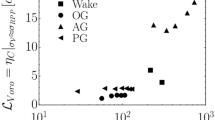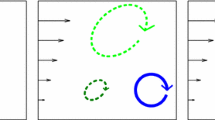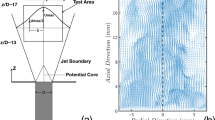Abstract
A new configuration for the transmitting optics of a laser Doppler anemometer has been developed in order to measure the velocity at two different points at the same time. From the simultaneous measurements at two points along the mean flow direction it is possible to evaluate the spatial correlations and to compare them with the temporal correlation to verify the validity limits of Taylor's hypothesis also known as the frozen turbulence hypothesis. The transfer function between the velocity signals at two different points has been introduced to better explain the differences between Taylor's hypothesis and non frozen flow. The analysis is carried out in a flow with high turbulence levels.
Similar content being viewed by others
References
Bendat, J. O.; Piersol, A. G. 1971: Random data: analysis and measurement procedures. Wiley Interscience
Champagne, F. H.; Harris G.; Corrsin, S. 1970: Experiments on nearly homogeneous turbulent shear flow. J. Fluid Mech. 41
Corrsin S.; Comte-Bellot, G. 1966: The use of a contraction to improve the isotropy of grid-generated turbulence. J. Fluid Mech. 25
Drain, L. E. 1980: The laser Doppler anemometry. New York: John Wiley & Son
Durst, F.; Melling, A.; Whitelaw, J. H. 1976: Principles and practice of laser Doppler velocimetry. Academic Press
Favre, A.; Gaviglio, J.; Dumas, R. 1953: Appareil de mesures de la correlation dans le temps et l'espace. Rech, Aeron. 31
Favre, A.; Gaviglio, J.; Dumas, R. 1957: Space-time double correlations and spectra in a turbulent boundary layer. J. Fluid Mech.
Favre, A.; Gaviglio J.; Dumas R. 1958: Further space-time correlations of velocity in a turbulent boundary layer. J. Fluid Mech. 3
Fisher, H. J.; Davies, P. O. A. L. 1964: Correlation measurement in a non-frozen pattern of turbulence. J. Fluid Mech. 8
Hinze, J. O. 1975: Turbulence. New York: Mc Graw Hill
Lin, C. C. 1953: On Taylor's hypothesis and the acceleration terms in the Navier-Stokes equations. Quart. Appl. Math. 10
Lumley, J. L. 1965: Interpretation of time spectra measured in highintensity shear flows. Phys. Fluids. 8
Monin, A. S.; Yaglom, A. M. 1965: Statistical Fluid Mechanics: mechanics of turbulence. MIT Press
Morton, J. B.; Clark, W. H. 1971: Measurements of two-point velocity correlations in a pipe flow using laser anemometers. J. Phys. E.: Scient. Instrum. 4
Nakatani, N.; Tokita, M.; Maegava, A.; Yamada, T. 1985: Simultaneous measurement of flow velocity variations at several points with multi-points LDV. Int. Conf. on Laser Anemometry-Advances and application. Manchester
Piomelli, U.; Balint, J. G.; Wallace, J. M. 1989: On the validity of Taylor's hypothesis for wall-bounded flows. Phys. Fluid. A 1
Pfeifer, H. S. 1986: Correlation and spectra density measurement by LDA. ISL-CO 244, ISL St. Louis, France
Smol'yakov, A. V.; Tkachenko, V. M. 1983: The measurement of turbulent fluctuations: Berlin Heidelberg New York Tokyo: Springer
Taylor, J. T. 1938: The spectrum of turbulence. Proc. Roy. Soc. A 164
Author information
Authors and Affiliations
Rights and permissions
About this article
Cite this article
Cenedese, A., Romano, G.P. & Di Felice, F. Experimental testing of Taylor's hypothesis by L.D.A. in highly turbulent flow. Experiments in Fluids 11, 351–358 (1991). https://doi.org/10.1007/BF00211789
Received:
Issue Date:
DOI: https://doi.org/10.1007/BF00211789




